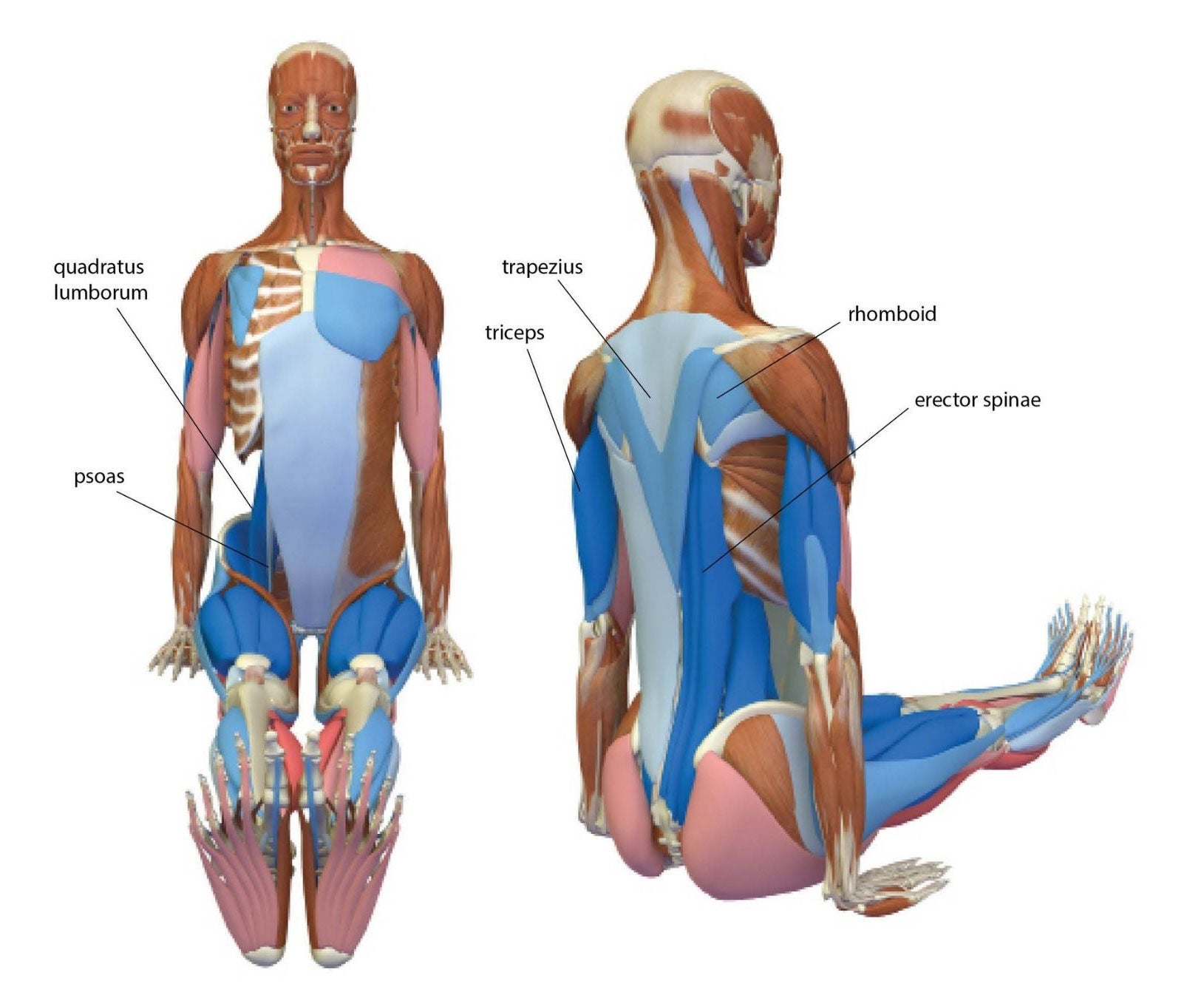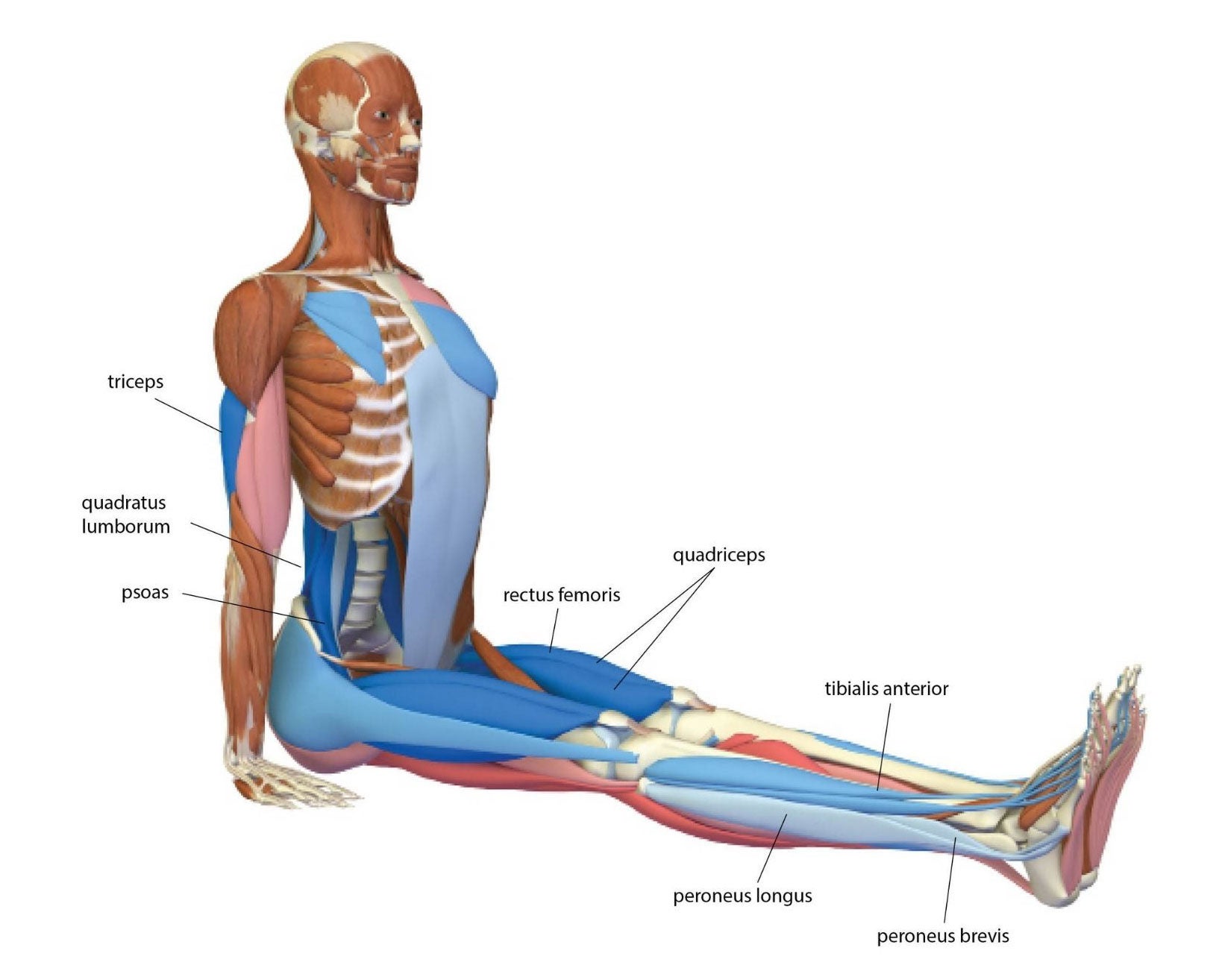Staff Pose
It might look straightforward, but there's more to Dandasana than meets the eye.
Heading out the door? Read this article on the new Outside+ app available now on iOS devices for members! Download the app.
Dandasana (Staff Pose) is a foundational seated pose which helps to improve posture and can set the tone for alignment for the rest of your yoga postures.
“Dandasana might seem like an easy pose,” says Yoga Journal contributor Gina Tomaine, “But so many of the facets of the rest of your yoga practice are present in this pose: activated back and shoulders, strong posture, reaching up from the crown of your head and down through your seat, activating your feet. Your alignment in Dandasana is just like your alignment in Tadasana. It can dictate how the rest of your practice will be.”
In Staff Pose, imagine your spine as the vertical “staff” of your torso, firmly rooted in the Earth and the support of all you do. A simple way to check your alignment is to sit with your back against a wall, with your sacrum and shoulder blades touching the wall—but not your lower back or back of the head. (To help keep the lower-back distanced, try putting a rolled-up towel between it and the wall.)
Section dividerSanskrit
Dandasana (dun-DAHS-anna)
danda = staff
Section dividerStaff Pose basics
Pose type: Seated pose
Targets: Upper body
Staff Pose benefits: In addition to improving your postural and body awareness, this pose strengthens your core and the front your thighs (quadriceps). It also allows for lift and expansion in the top of your chest.
Other Staff Pose perks:
- Strengthens your back and hip flexors
How to
- Begin seated with your legs extended forward.
- Bring your hands alongside your hips and straighten your arms.
- Touch your big toes together and keep a small amount of space between your heels.
- Flex your ankles, drawing your toes back.
- Press forward with your big toe mounds. Rotate your inner thighs in and down and press down with your femurs.
- Extend your sternum away from your navel and broaden your collarbones.
- Draw the heads of your upper arms back while softening your front ribs.
- To exit the pose, release your arms and shake out your legs.
Beginner tips
- Lay props or a blanket across the tops of your thighs at the hip crease to help ground your thighs.
- To activate your legs in this pose, flex your ankles, pressing out through your heels.
Explore the pose
In this pose, imagine your spine as the vertical “staff” of your torso, firmly rooted in the Earth and the support of all you do. If you struggle to ground your thighs into your mat, lay one to three 10-pound sandbags or a dumbbell across the tops of them.
It’s important not to round your back or stick out your chin in Staff Pose; this will restrict your breathing and can strain your lower back. If your back is rounding, sit on a folded blanket or pillow, so that your hips are lifted and higher than your knees. If your hands do not reach the mat, place them on blocks, books, or folded blankets to bring the ground to you.
Be mindful!
Don’t overarch your back or push your chest out—this will overwork your hip flexors and put pressure on your sacroiliac joint.
Section dividerTeacher tips
These cues will help protect your students from injury and help them have the best experience of the pose:
- To lengthen your front torso perpendicular to the floor, think of energy streaming upward from the pubis to the sternum, then down the back from your shoulders to your tailbone. Then, imagine your tail lengthening into the floor.
- If your torso is leaning back, it may be because tight hamstrings are dragging the sitting bones toward your knees and the back of the pelvis toward the floor. It may be helpful to sit on a blanket or a bolster to lift the pelvis.
- If you can’t press your palms into the ground, place them on a blanket or blocks instead.
Variations
Staff Pose with support
To help create a forward tilt in your pelvis and prevent slouching, sit on the edge of one or more folded blankets. If you have tight hamstrings or your knees tend to hyperextend, place a rolled blanket under your knees.
Staff Pose against a wall
Try sitting with your back against a wall for extra support. You may want to sit on one or more folded blankets.
Section dividerWhy we love this pose
“In Dandasana, the difference among bodies is immediately obvious. Some of use have shorter arms and longer torsos; others have longer arms and shorter torsos. People in that first group (myself included) won’t be able to press their palms into the floor while sitting in Staff Pose. Consequently, we have both an opportunity to see things as they are and accept what we can’t change, and a chance to make friends with props like blocks.” says Yoga Journal contributor Sage Rountree.
Section dividerPreparatory and counter poses
Though a challenging pose, Dandasana does not require much stretching prior to practicing it. Any pose that lengthens your back body will set you up well.
Preparatory poses
Uttanasana (Standing Forward Bend)
Adho Mukha Svanasana (Downward-Facing Dog)
Counter poses
Purvottanasana (Reverse Plank Pose)
Paschimottanasana (Seated Forward Bend)
Section dividerAnatomy
Dandasana is like a home position that you return to between various supine and prone postures on the floor, explains Ray Long, MD, a board-certified orthopedic surgeon and yoga teacher. This is analogous to how you use Tadasana (Mountain Pose) to recalibrate during the standing poses. As with Chaturanga Dandasana, you can also practice Dandasana by itself, outside of your usual yoga routine, to strengthen the muscles that hold your back and knees straight and stable, along with those that bend your hips in a controlled fashion.
In the drawings below, pink muscles are stretching and blue muscles are contracting. The shade of the color represents the force of the stretch and the force of contraction. Darker = stronger.

The erector spinae (muscles along the spine) and the quadratus lumborum in the lower back combine with the psoas at your upper thigh to lift and stabilize your lower back. The triceps straighten your elbows and help you to push your hands into the floor, further lifting your back. The trapezius combines with the rhomboid muscles to draw the shoulder blades toward the spine and downward, opening your chest.
The psoas, pectineus, and rectus femoris flex the hips. The adductors, located along the inner thigh, draw the upper leg bones toward the midline. The quadriceps straighten your knees. One of the quadriceps, the rectus femoris, also contributes to flexing the hips.

Muscles along the edge of the shins (tibialis anterior) shorten to make “right-angle ankles.” The pose is finessed as the peroneus longus and brevis muscles (along the outside of the lower leg) turn the ankles slightly outward to open the soles of your feet.
Excerpted with permission from The Key Poses of Yoga by Ray Long.
Put Staff Pose into practice:
Ready to put this seated posture into practice? Here’s a few flows to try:
A Yin Yoga Sequence for When You Feel Outrage
This Home Practice Will Help You Close (Yes, Close) Your Heart After Grief
Section divider
About our contributors
Teacher and model Natasha Rizopoulos is a senior teacher at Down Under Yoga in Boston, where she offers classes and leads 200- and 300-hour teacher trainings. A dedicated Ashtanga practitioner for many years, she became equally as captivated by the precision of the Iyengar system. These two traditions inform her teaching and her dynamic, anatomy-based vinyasa system Align Your Flow. For more information, visit natasharizopoulos.com.
Ray Long is an orthopedic surgeon and the founder of Bandha Yoga, a popular series of yoga anatomy books, and the Daily Bandha, which provides tips and techniques for teaching and practicing safe alignment. Ray graduated from the University of Michigan Medical School and pursued post-graduate training at Cornell University, McGill University, the University of Montreal, and the Florida Orthopedic Institute. He has studied hatha yoga for over 20 years, training extensively with B.K.S. Iyengar and other leading yoga masters, and teaches anatomy workshops at yoga studios around the country.